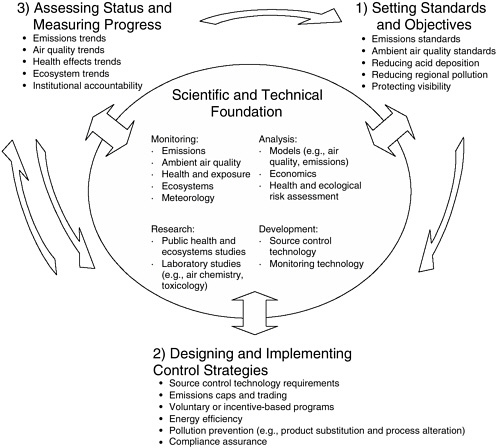Basics of SIP Requirements
When EPA establishes a new national ambient air quality standard (NAAQS) or revises an existing NAAQS, it sets in motion two major actions aimed at ensuring that air quality throughout the country meets those standards:
1) EPA must designate areas as meeting (attainment) or not meeting (nonattainment) the standard; and
2) The Clean Air Act (CAA) requires states to develop State Implementation Plans (SIPs): a general plan to attain and maintain the NAAQS in all areas of the country, and a specific plan to attain the standards for each area designated nonattainment for a NAAQS.

The SIP's main purposes
- Demonstrate that the state has the basic air quality management program components in place to implement a new or revised NAAQS.
- Identify the emissions control requirements the state will rely upon to attain and/or maintain the primary and secondary NAAQS.
- Prevent air quality deterioration for areas that are in attainment with the NAAQS, and to reduce common or criteria pollutants emitted in nonattainment
State Plans Required for All States – Infrastructure SIPs
Within 3 years of EPA issuing the standard, all states are required to submit SIPs with general infrastructure elements showing the state has the capacity to attain, maintain, and enforce a new or revised NAAQS. These SIP submittals must include the basic program requirements for managing air quality required in section 110(a)(2) of the CAA such as:
- ambient air quality monitoring and data systems;
- programs for enforcement of control measures; and
- adequate authority and resources to implement the plan.
State Plans Required for States with Areas Not Meeting the Air Standard – Nonattainment SIPs
In addition to the basic required elements, CAA Section 172 requires states with nonattainment areas to adopt additional regulatory programs designed to achieve and maintain attainment of the relevant NAAQS.
General Clean Air Act Plan Requirements for Areas Not Meeting the Air Standard
The general plan requirements for each nonattainment area are specified in subpart 1 of the Clean Air Act Part D. The additional provisions for each respective NAAQS are specified in subpart 2 to subpart 5 in the Part D - Plan Requirements for Nonattainment Areas:
- Subpart 2 - Additional Provisions for ozone nonattainment areas
- Subpart 3 - Additional Provisions for carbon monoxide nonattainment areas
- Subpart 4 - Additional Provisions for particulate matter nonattainment
- Subpart 5 - Additional provisions for designated nonattainment for sulfur oxides, nitrogen dioxide, or lead
Consult your state's environmental agency to learn more about your state's SIP requirements and how you can be involved.
